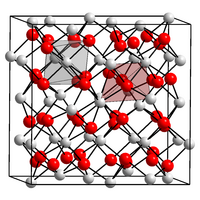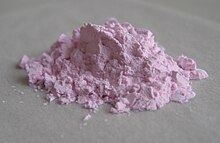Erbium (III) oxide
| Crystal structure | ||||||||||||||||
|---|---|---|---|---|---|---|---|---|---|---|---|---|---|---|---|---|

|
||||||||||||||||
| __ Er 3+ __ O 2− | ||||||||||||||||
| General | ||||||||||||||||
| Surname | Erbium (III) oxide | |||||||||||||||
| other names |
|
|||||||||||||||
| Ratio formula | He 2 O 3 | |||||||||||||||
| Brief description |
pink solid |
|||||||||||||||
| External identifiers / databases | ||||||||||||||||
|
||||||||||||||||
| properties | ||||||||||||||||
| Molar mass | 382.52 g mol −1 | |||||||||||||||
| Physical state |
firmly |
|||||||||||||||
| density |
8.64 g cm −3 (25 ° C) |
|||||||||||||||
| Melting point |
2344 ° C |
|||||||||||||||
| boiling point |
3920 ° C |
|||||||||||||||
| solubility |
|
|||||||||||||||
| safety instructions | ||||||||||||||||
|
||||||||||||||||
| Toxicological data | ||||||||||||||||
| As far as possible and customary, SI units are used. Unless otherwise noted, the data given apply to standard conditions . | ||||||||||||||||
Erbium (III) oxide is a chemical compound from the group of oxides .
history
Erbium (III) oxide was partially isolated (as a mixture of several lanthanide oxides) in 1843 by Carl Gustaf Mosander and first produced in pure form in 1905 by Georges Urbain and Charles James .
Extraction and presentation
Erbium (III) oxide can be obtained by burning erbium in air.
It can also be obtained by thermal decomposition of erbium salts such as erbium nitrate or erbium oxalate.
properties
Erbium (III) oxide is a hygroscopic pink powder that is insoluble in water. It has a cubic crystal structure. An interesting property is the photon upconversion .
use
Erbium (III) oxide is used to color glasses and ceramics. Since it absorbs infrared light in the corresponding glasses, it is used for protective goggles in the glass and steel industry. It also serves as the starting material for the production of pure erbium.
Individual evidence
- ↑ a b c d e f David R. Lide (Ed.): CRC Handbook of Chemistry and Physics . 90th edition. (Internet version: 2010), CRC Press / Taylor and Francis, Boca Raton, FL, Properties of the Elements and Inorganic Compounds, pp. 4-63.
- ↑ a b c d e data sheet Erbium (III) oxide, ≥99.99% trace metals basis from Sigma-Aldrich , accessed on March 2, 2012 ( PDF ).
- ^ Aaron J. Ihde: The Development of Modern Chemistry. Dover Publications, 1970, ISBN 978-0-486-64235-2 , p. 377 ( limited preview in Google book search).
- ↑ Gerd Meyer, Lester R. Morss: Synthesis of lanthanide and actinide compounds . Springer Netherlands, 1990, ISBN 978-0-7923-1018-1 , pp. 195 ( limited preview in Google Book search).
- ↑ Reade: erbium oxide powder (Er 2 O 3 ) ( Memento from January 9, 2012 in the Internet Archive )
- ↑ American Elements: Erbium Oxide
- ^ John Emsley: Nature's building blocks: an AZ guide to the elements . 2003, ISBN 978-0-19-850340-8 , pp. 137 ( limited preview in Google Book search).



